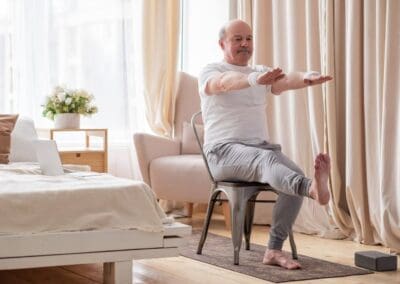Everyone knows that exercise is good for you. Yet the older we get, the less exercise we do. A Report of the Surgeon General states that by age 75, about 1 in 3 men and 1 in 2 women engage in no physical activity at all.
This sedentary lifestyle is a recipe for a troublesome old age. Without regular exercise, we become weaker and less flexible. Our mood and energy level head south, along with our quality of life. We’re more likely to fall and break a bone. And we increase the risk of serious illness including strokes, heart attacks, liver problems, cancers, diabetes, osteoporosis and dementia.
Pretty discouraging, isn’t it? The good news is that it’s largely preventable. All you have to do is pull yourself away from the screen, get up and start moving.
Every little movement helps
You don’t have to join a gym or take up jogging to get more exercise. Pick any activity that gets your heart rate up. Here are some suggestions to get you moving:
- Walk around the block or go for a walk in the park.
- Join a walking group in your neighborhood or at the local shopping mall.
- Clean the house or wash the car.
- Do stretching exercises while watching TV.
- Tend a vegetable or flower garden.
- Take the stairs instead of the elevator.
- Put on some music and boogie to your favorite tunes. Or join a dance class.
- Go for a swim.
- Skip the golf cart and walk the course.
- Play tennis or pickleball.
- Most important — have fun while being active!
Even a single bout of exercise can help you feel better, think better and sleep better. And once you start seeing the benefits of exercise, you’ll gain the motivation to do more of it. You might even want to track your progress. There are lots of free fitness apps for seniors available for your phone. The National Institute on Aging also has a collection of free “Go4Life” exercise videos for older adults on YouTube.
9 more ways exercise for seniors can benefit your health:
- Arthritis – Regular exercise helps lubricate the joints and reduces pain and stiffness. Exercise can also help you lose weight so you’re not putting as much pressure on your joints.
- Heart disease – Exercise can help lower your blood pressure, your blood glucose level and your LDL cholesterol—all contributing factors to heart disease.
- Cancer – Exercise reduces your risk of a variety of types of cancer. For women who exercise regularly, studies show a 40 percent reduction in breast cancer risk.
- Dementia – A recent study showed a 66% reduction in risk of dementia when older adults performed moderate-intensity exercise.
- Insomnia – When your body is tired from exercise, you’ll sleep deeper and longer, and wake up rested and raring to go.
- Mortality –Some 70% of premature death and aging is lifestyle-related. Regular exercise, along with a healthy diet, can help you live longer and better.
- Depression – Studies suggest exercise can treat mild to moderate depression as effectively as antidepressant medication — without the side-effects.
- Stress – Exercise helps relax muscles and relieves tension in your body. It also triggers the release of endorphins, chemicals in your brain that induce a sense of well-being.
- Mental decline – Mental benefits of exercise for seniors include improved concentration, motivation, memory and mood. Exercise also stimulates the growth of new brain cells and helps prevent age-related decline.
Start slowly, build gradually, but start today.
You can reap all the physical and mental health benefits of exercise with 30 minutes of moderate exercise five times a week. If that seems like a lot, try 2 15-minute sessions or even 3 10-minute sessions spread out over the course of the day.
If you haven’t exercised lately, or if you’re concerned about a known or potential health problem, consult your physician before starting a senior exercise program. A few sessions with a trainer is also a good idea. Your trainer will ensure you’re doing the exercises correctly so you don’t hurt yourself.
3 types of exercises for total fitness.
- Aerobic – Walking, cycling, swimming, jogging or indoor workouts on a treadmill or elliptical machine are all examples of aerobic or cardio exercises.
- Strength – This can be done in a gym on various machines that each work a different set of muscles. Or use resistance bands, dumbbells or your own body weight. (Think lunges, leg raises, sit-ups, etc.)
- Stretching and flexibility – Improving balance and bone density with yoga, Pilates and Tai Chi are all good ways to maintain flexibility, strengthen your core and improve balance.
Sedgebrook—where wellness is a way of life.
At Sedgebrook, we recognize the importance of exercise for the physical and mental health of our residents. So we’ve partnered with the National Institute for Fitness and Sport to provide a dynamic senior exercise program.
NIFS-certified trainers work with residents to develop individualized programs to help them reach their goals. In addition, we offer group classes in our fitness and aquatics center. To learn more about our wellness program, contact us form.



